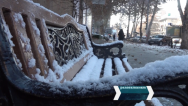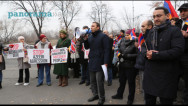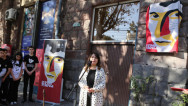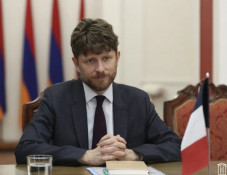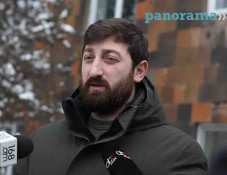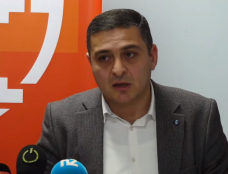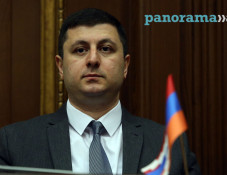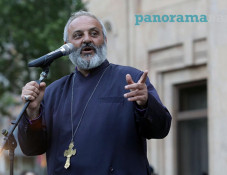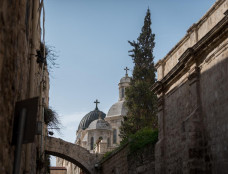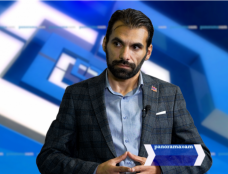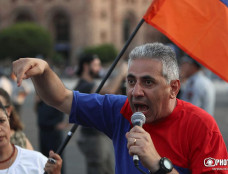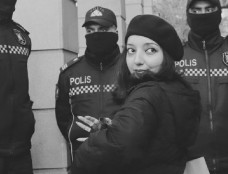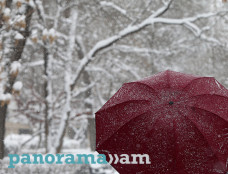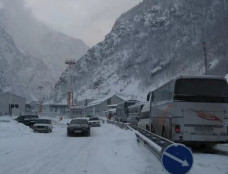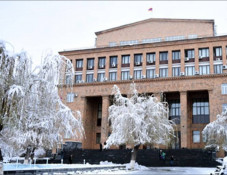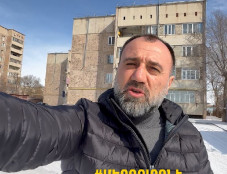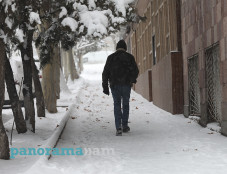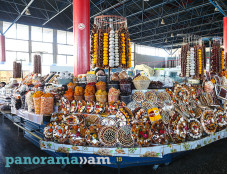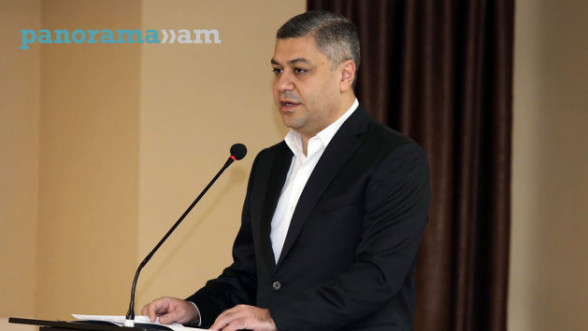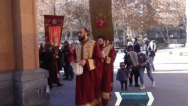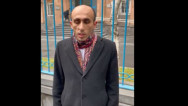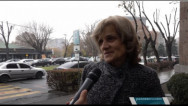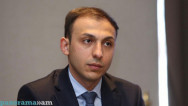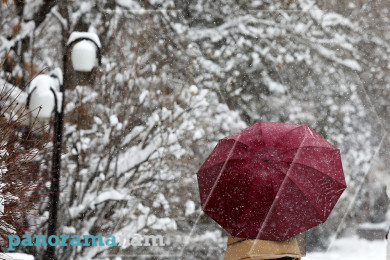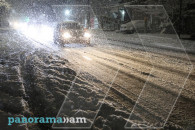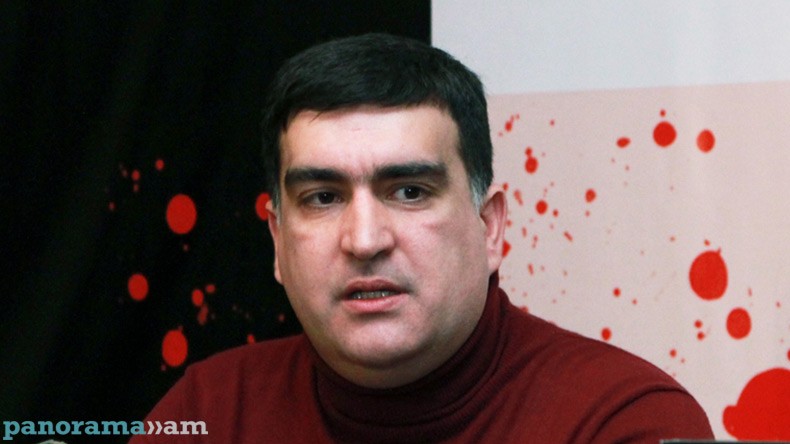
Aris Ghazinyan: People surviving in various districts of Biblical highland were gathering in Yerevan
According to Arakel Davrizhetsi, the Persians actually used the scorched earth policy destroying and ruining Armenia because of the Ottoman troops in order to deprive them of any provision. Armenian journalist and researcher Aris Ghazinyan writes about it in his book “Yerevan: with a cross or on the cross,” which is an attempt of setting and considering an extremely diverse range of processes directly or indirectly forming the character of the development of the territory in question and predetermining the inevitability of turning Yerevan into the main centre of the Eastern Armenia, and later on into the capital of the recovered Armenian state.
Here is what Jean Chardin, a French merchant who visited Armenia in the 1670s, writes about the situation there, “…I parted from Erivan, and travell'd four Leagues over the little Hills, and through Valleys, <…> [On the next day] we travell'd five Leagues through a Country that was very level and fertile. That which they call the Mountain of Noah, lying upon the Right Hand. <…> we continu'd the same Road, and travell'd eight Leagues. Upon the left hand, after we got half the way, we left a great Town call'd Sederec. Which is as it were the Capital of the Province of Armenia, call'd Charour. <…> The 11. We travell'd four Leagues upon the same Road, and through a very fair Country. <…> We also ferry'd over a River call'd Harpasony, that waters all the Neighbouring Lands. It separates the Government of that part of Armenia, of which Erivan is the Capital, from that other part of which Nacchivan [Nakhijevan] is the Metropolis.
“…Nacchivan is a great City, or rather a vast heap of Ruins. <…> There are in it <…> two Thousand Houses or thereabouts. <…> formerly it contain'd above Forty Thousand. <…> Without the City are to be seen the Ruins of a great Castle, and several Forts which Abas caus'd to be destroy'd, toward the end of the last Age, not finding him∣self strong enough to keep 'em: All which he caus'd to be ruin'd, after he had taken Nacchiavan from the Turks; and after he had ruin'd and dispeopl'd the City. Which he did to prevent the Turks from Fortifying themselves in that Place, and furnishing themselves with Provisions. Most certainly the City is an Object of Pity, considering in what a Condition it now lies. The Histories of Persia would have us believe, that it was one of the Greatest and Fairest Cities of all Armenia. <…> Armenian Authors make Nacchivan to be much more Ancient, and assert that Noah began to build it, and made it his Abode after the Deluge. And they make the Etymology of the Name to agree with the Antiquity of the Original: Affirming, that in the old Armenian Language Nacchivan signifies the first Habitation.
“…We departed from Nacchivan, and travell'd seven Leagues: At the end of the first League passing a River over a very broad Bridge. <…> The Country which we pass'd is dry and Stony, where was nothing to be seen but little Hills of Stones. We lay upon the Banks of the River Araxes. <…> We pass it at Esqui-julfa, or Julfa the old, a ruin'd City. <…> They call'd it Old to distinguish it from Julfa, that is built over against Ispahan. Nor is it without reason so call'd, as being totally ruin'd and demolished. There is nothing farther to be known of it, except the Grandeur, which it once enjoy'd. It was seated upon the descent of a Mountain, by the side of a River, that ran close by it.
“…I do not believe there is in the world a more barren or hideous Place, then that of Old Julfa, where there is neither Tree nor Grass to be seen. True it is, that in the Neighbourhood there are some Places more happy and fertile; yet on the other side it is as true, that never was any City seated in a Situation more dry and stony. But the Figure of it somewhat recompens'd the Situation, resembling a long Amphitheater. At present there are not above thirty Families in it, which are all Armenians. Abas the Great was the Prince that ruin'd Julfa, and all that Art had contributed to its Fortification. Which he did for the same reason that he ruin'd Nacchivan and other Places, of Armenia, to hinder the Turkish Armies from Provisions.
“For he being a prudent and Politick Captain <…> resolv'd to make a Desart of all the Country between Erzerum &Tauris, upon the line of Erivan and Nacchivan; which was the road which the Turks usually observ'd, and where they fortifi'd themselves, because they found provisions sufficient for the support of their Armies. To that purpose therefore he transplanted all the Inhabitants and Cattel, ruin'd all the Houses and Buildings; fird all the Country, burnt up all the Turf and the Trees, poyson'd the very Springs, as the History relates; and they who have read the Story well know.”
The shah’s eagerness to develop his country economically and turn the new capital, Isfahan, into a centre of world trade became another important factor of deporting the Armenians. That is why he concentrated the majority of the resettled population in a suburb of the capital. Here, the Armenians founded Nor Jugha (New Julfa), a city that soon became an incubator of craftsmen and traders of the entire East.
Extremely interested in exploiting the Armenian potential, the shah not only withheld from overt religious oppressions, but also encouraged the construction of religious buildings in Nor Jugha (Isfahan Julfa). During the first years of the deportation, the Armenians erected the temple of St. Amenaprkich and a number of churches (St. Astvatsatsin, St. George and others). The shah granted more privileges to the Armenians, and Isfahan soon turned into a grandiose trade centre between the East and the West, the North and the South. Abbas himself annulled the trade agreement between England and Persia and gave the whole monopoly of trade with raw silk to the Armenians of Isfahan (of New Jugha), Ghazinyan writes.
The Muslims, especially the clergy, were offended of the shah’s non-interference in the Christians’ activities. The clergy asked the shah, “Why have you allowed the Armenians to become so daring or why do you fail to bring them from their prodigal faith to the true faith of Muhammad?” And the shah told them about the secret of his heart, “Do not be upset about my transient and vain love for them, and do not you scold me, for I have forcibly brought them to our country at the cost of huge expenses, efforts and ruses. Still, I did not do it for the sake of their benefit but for ours, for the sake of the well-being of our country. <…> Even if you tear them into pieces, none of them will adopt our religion. This will frighten the rest of them and they will secretly go back to their country. As a result, our efforts will be lost in vain. This is why I demonstrate love towards them so that they stay in our country. The old people, who were born in Armenia and resettled here, will soon die. <…> And if you care about the benefit of our people, follow my example.”
The Armenians of Isfahan really took leading positions in crafts and trade very quickly and successfully maintained “the right to trade” in the area of the Indian Ocean rivalling with the East India Company, Ghazinyan points out.
“There is an impression that the shah resolved the problem, which Lawrence of Arabia, a British intelligence officer, spoke about three centuries later, ‘Armenia was to be divided. The back country, where the natural wealth is, was to be cut off from the front, where there is nothing but Armenians. <…> The Armenians must not have Armenia, not the back lands. <…> I tell you that if ever the Armenians are given a fair start in the world, if they get a free hold of any corner of the earth, they will own the whole planet and work all the rest of mankind. That’s what <…> know and dread <…> all of us who know them,’” Ghazinyan writes.
Abbas I sought to “separate Armenia from the Armenians.” According to Davrizhetsi, he was destroying Armenia also to make the Armenians’ heart tremble at that sight and keep them from going back. To make sure that the Armenian resource would stay in Persia proper, Shah Abbas resettled Catholicos David IV of Vagharshapat to Isfahan. However, even granting unprecedented freedom and privileges to the Armenians, the shah failed to master them completely. “Abbas had repeatedly heard that the graves of the fathers and the ancestors in Armenia, the monasteries, the places of pilgrimage, the tombs of saints, and especially See of Holy Etchmiadzin, where the holy Right Hand of Gregory the Illuminator rests – used to consecrate the holy Myron – and it is spread among the Armenians all over the world from there no matter where they might be. That is why the entire Armenian nation only obeys to the See of Holy Etchmiadzin and to the catholicos sitting there. These words were stated not only by ignorant and insignificant people but also by noble and intelligent ones,” Davrizhetsi writes.
As a result, the shahanshah made up his mind to take an unprecedented step in order to finally “separate of the Armenians and Armenia.” “Abbas strictly and persistently decided to eliminate Holy Etchmiadzin, suppress the catholicosate there, bring the Illuminator’s Right Hand and the stones of Etchmiadzin to Isfahan and erect a New Etchmiadzin there for the catholicos to reside in. He chose a place in Isfahan where he wanted to construct Etchmiadzin,” Ghazinyan writes.
The resettlement could really have a devastating and irreversible impact on the perspectives of the “Armenian Yerevan,” especially given that the population was already rather an organised community by the early 17th century. The majority of the resettled people died on the way, especially while crossing the river Arax. Less than 120,000 people were able to reach the inside of Persia. According to Antonio de Gouvea, Muslims rather than the Christian Armenians whom the shah had taken into Persia were resettled into Yerevan. However, neither the Portuguese diplomat, nor anyone else reports about no Armenian families remaining in Yerevan after the Great Surgun. On the contrary, chroniclers mention Armenians from Yerevan and even “well-to-do residents.” For example, there is information about Khoja Grigor constructing a chapel on the western side of the Church Katoghike in 1607 and giving ancient manuscripts and precious utensils to it. This was the period when the families that had fled from Yerevan to hide themselves in the caves of Gegham Mountains and Plateau Aragatsotn came back to their abandoned houses.
Zakaria Kanakertsi portrays a reliable panorama of Yerevan of those times, “And the Ararat country was left deserted and uninhabited. That is why beasts started to breed in the country, make their lairs in villages and houses and give birth to cubs. Among those beasts were leopard, bear, hyena, wolf, fox, marten, hedgehog and others resembling them, big and small. No people were remaining to drive them away, and they were bravely wandering everywhere. However, the wolves were the bravest of all the other beasts. As the people remaining there were old men and women and feeble people, who had not been able to go with the rest, the wolves were coming, tearing them to pieces and gobbling. After eating up the sick ones, they got used to the human flesh and started to gobble up the healthy people as well if they met them. Hence they were called cannibal wolves.”
Such records evidence that there was Armenian population, although few, remaining in the Ararat region. This contingent was destined to play a key role in the process of safeguarding the perspectives of the Armenian Yerevan. The urban population from Van, Bitlis, Mush and Khnus gathered exactly in Yerevan, marking the start of the process of creating the Yerevan resident of a new type, Ghazinyan writes.
The demographic processes in Yerevan were controlled by Amirgun Khan, the new beglerbeg of Yerevan. If in 1603 and 1604 he was the one to resettle the Armenian population out of the Ararat region sending them to Persia, a year later he was coordinating the voluntarily started process of the “resettlement of the folks who had survived” to Yerevan. According to Ghazinyan, such an alteration of the Safavids’ demographic policy was conditioned by the changes in Shah Abbas’ approach towards the Armenian population. By resettling their more competent layer into Persia and thus isolating the “islets of the Armenian life” from each other, he intended to construct an anti-Ottoman boundary from “Armenian bricks” along the north-western part of the border.
In the first quarter of the 17th century, Yerevan was transforming into the sole place in Armenia where the people surviving in the various districts of the Biblical highlands were gathering and contributing to it with their creative potential. Movses Tatevatsi reconstructed the Poustinia of St. Ananias the Apostle in Yerevan, opened schools in Ararat region (Hovhannavank, Saghmosavank). He also managed to get Isfahan stop the officials’ abuses and free the Church from taxes.
After Shah Abbas’ death in 1629 and his grandson Safi I’ ascending the throne, the 17-year-old sultan of the Ottoman Empire, Murad IV, captured Yerevan in August 1635. This was when a decision was made to restore the Yerevan Fortress. After the completion of the works, janissaries and other troops – twelve thousand of them – were appointed as Revan’s guards. However, the Armenians of Yerevan and the new Persian beglerbeg Tahmasp Khan, who was the son of Amirgun Khan, recaptured the city from the Turks inciting a new wave of tension, Ghazinyan writes.
In 1636, Shah Safi sieged Yerevan with a hundred thousand troops. As a result, the Ottoman governor of the city was killed and the bashaws were taken captive. The contours of the autonomy of Ararat region with Yerevan as its centre became more distinguished after a peace agreement was signed between the Ottoman Empire and Persia in 1639. This was preceded by two important events.
First, Catholicos Philippos I Albaketsi returned the Right Hand of St. Gregory the Illuminator to its homeland from Isfahan. It had been in the Safavid capital since 1612. The significance of this event is that the representatives of the national elite already allowed themselves to speak out against the “precepts of Abbas I” of moving the focus of the Armenian ideological life into Persia proper. Remarkably, the Right Hand had been taken to Isfahan under a decree issued directly by Tahmasp, the beglegbeg of Yerevan. Accordingly, the new Armenian leaders openly went against him, too.
Second, the Ottomans took up another attempt to take Yerevan under their control. Sultan Murad IV ordered the eastern pashas to gather troops and siege Yerevan again. Over forty thousand troops, including five hundred Tatars sent to the sultan by the khan of Crimea, took part in the siege of Yerevan. In May 1639, the sides signed the Treaty of Qasr-e Shirin, which gave Yerevan an eighty-year-long peace. The city was left to Persia.
Safi I died in 1642 and his son Abbas II inherited the throne. Yerevan was remaining within the boundaries of the Safavid Empire, and the Sunni religious structures were naturally reconstructed in Shia manner. The city, however, was developing as an Armenian centre. Philippos I strengthened the ties between the church dioceses in Persia, which were obeying to Etchmiadzin, and the Armenian parish in the Ottoman Empire. As a response, the Ottoman authorities declared Eghiazar, the Patriarch of Constantinople, as the leader of the Armenian Church.
Meanwhile, the Ararat Armenians made plans and perspectives, including from tufa, according to Ghazinyan. The Poustinia of St. Ananias the Apostle was completely restored in Yerevan with a new church (Most Holy Lady Theotokos) and refectory and monastery school. Its fame, according to the contemporaries, reached the farthest borders of the Ottoman and Safavid empires, as well as Orthodox Georgia and Greece. Another important circumstance, according to Ghazinyan, was the sponsorship of the well-to-do new residents of Yerevan to the development of the national life there.
To be continued
Aris Ghazinyan’s “Yerevan: with a cross or on the cross” is a book about the social and political history of Yerevan and Yerevan district (as a habitat) since the declaration of Christianity to the beginning of XIX century. In addition to demonstrating historical facts based on archive documents and sources, the book also considers the fundamental theses of the Azerbaijani historiography and Pan-Turkic ideology aimed at appropriating the historical, cultural, and spiritual heritage of the Armenians and other nations of the region by falsifying their history.
Related news
- Aris Ghazinyan: Seeing Armenians’ well-ordered lands, Abbas I started working out plans of using Armenian resource in economic development of country
- Aris Ghazinyan: Timur took thousands of Armenians out of Armenia to develop crafts and trade in his empire
- Aris Ghazinyan: Yerevan became place of pilgrimage for Christians since late 13th century
- Aris Ghazinyan: Average seventh-century inhabitant of Yerevan embodied collective image of the Armenian of that time
- Aris Ghazinyan: Territory of Yerevan generates unlimited time in its limited borders
Newsfeed
Videos


